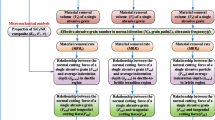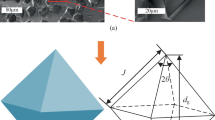Abstract
SiCf/SiC composites have been applied in numerous fields owing to their outstanding properties including high specific strength and high specific modulus. However, defects can be produced during grinding because the composites are hard and brittle. Moreover, the fabrication process of laminated SiCf/SiC composites is complex and unstable, resulting in large differences in their elastic properties. Therefore, the effective elastic properties of composites must be obtained through theoretical analysis. In this study, the anisotropy of orthogonal laminated SiCf/SiC composites and the fracture removal mechanism of the brittle material were both considered to develop a more accurate model. The effective elastic constants of the laminated composites were calculated using a macromechanical analysis. The grinding process was divided into the ductile, ductile-to-brittle transition, and brittle stages for analysis by the critical cutting depth. The modelling development was based on the interaction between the diamond grains and the workpiece. Substituting the effective elastic constants into the model, the predicted value is in agreement with the experimental value. The cutting force value exhibits a non-linear decreasing trend with increasing spindle speed but increases linearly with increasing feed rate and cutting width. The spindle speed and cutting width have more influence on the cutting force than the feed rate. Increasing the spindle speed and decreasing the feed rate and cutting width can reduce the cutting force. The model can be applied to adequately evaluate the effective elastic properties of laminated SiCf/SiC composites and effectively improve the grinding processes and machining efficiency in future applications.










Similar content being viewed by others
Data availability
All data generated or analysed during this study are included in this article.
References
Wang Y, Sarin VK, Lin B, Li H, Gillard S (2016) Feasibility study of the ultrasonic vibration filing of carbon fibre reinforced silicon carbide composites. Int J Mach Tools Manuf 101:10–17. https://doi.org/10.1016/j.ijmachtools.2015.11.003
Qu S, Gong Y, Yang Y, Xu Y, Wang W, Xin B, Pang S (2020) Mechanical model and removal mechanism of unidirectional carbon fibre-reinforced ceramic composites. Int J Mech Sci 173:105465. https://doi.org/10.1016/j.ijmecsci.2020.105465
Hu Y, Shi D, Hu Y, Zhao H, Sun X, Wang M (2019) Experimental investigation on the ultrasonically assisted single-sided lapping of monocrystalline SiC substrate. J Manuf Process 44:299–308. https://doi.org/10.1016/j.jmapro.2019.06.008
Dong X, Shin YC (2017) Improved machinability of SiC/SiC ceramic matrix composite via laser-assisted micromachining. Int J Adv Manuf Technol 90:731–739. https://doi.org/10.1007/s00170-016-9415-5
Wang L, Hu Z, Fang C, Yu Y, Xu X (2018) Study on the double-sided grinding of sapphire substrates with the trajectory method. Precis Eng 51:308–318. https://doi.org/10.1016/j.precisioneng.2017.09.001
Yin J, Xu J, Ding W, Su H (2021) Effects of grinding speed on the material removal mechanism in single grain grinding of SiCf/SiC ceramic matrix composite. Ceram Int 47:12795–12802. https://doi.org/10.1016/j.ceramint.2021.01.140
Gavalda Diaz O, Axinte DA, Butler-Smith P, Novovic D (2019) On understanding the microstructure of SiC/SiC Ceramic Matrix Composites (CMCs) after a material removal process. Mater Sci Eng A 743:1–11. https://doi.org/10.1016/j.msea.2018.11.037
Qu S, Gong Y, Yang Y, Cai M, Xie H, Zhang H (2019) Grinding characteristics and removal mechanism of 2.5D-needled Cf/SiC composites. Ceram Int 45:21608–21617. https://doi.org/10.1016/j.ceramint.2019.07.156
Mir A, Luo X, Sun J (2016) The investigation of influence of tool wear on ductile to brittle transition in single point diamond turning of silicon. Wear 364–365:233–243. https://doi.org/10.1016/j.wear.2016.08.003
Sun J, Qin F, Chen P, An T (2016) A predictive model of grinding force in silicon wafer self-rotating grinding. Int J Mach Tools Manuf 109:74–86. https://doi.org/10.1016/j.ijmachtools.2016.07.009
Huang C, Zhou M, Zhang H (2021) A cutting force prediction model in axial ultrasonic vibration end grinding for BK7 optical glass considering protrusion height of abrasive grits. Meas J Int Meas Confed 180:109512. https://doi.org/10.1016/j.measurement.2021.109512
Xiao X, Zheng K, Liao W, Meng H (2016) Study on cutting force model in ultrasonic vibration assisted side grinding of zirconia ceramics. Int J Mach Tools Manuf 104:58–67. https://doi.org/10.1016/j.ijmachtools.2016.01.004
Dai J, Su H, Yu T, Hu H, Zhou W, Ding W (2018) Experimental investigation on materials removal mechanism during grinding silicon carbide ceramics with single diamond grain. Precis Eng 51:271–279. https://doi.org/10.1016/j.precisioneng.2017.08.019
Cheng J, Yu T, Wu J, Jin Y (2018) Experimental study on “ductile-brittle” transition in micro-grinding of single crystal sapphire. Int J Adv Manuf Technol 98:3229–3249. https://doi.org/10.1007/s00170-018-2503-y
Rao X, Zhang F, Luo X, Ding F, Cai Y, Sun J, Liu H (2019) Material removal mode and friction behaviour of RB-SiC ceramics during scratching at elevated temperatures. J Eur Ceram Soc 39:3534–3545. https://doi.org/10.1016/j.jeurceramsoc.2019.05.015
Zhang X, Kang Z, Li S, Shi Z, Wen D, Jiang J, Zhang Z (2019) Grinding force modelling for ductile-brittle transition in laser macro-micro-structured grinding of zirconia ceramics. Ceram Int 45:18487–18500. https://doi.org/10.1016/j.ceramint.2019.06.067
Yin W, Duan C, Li Y, Miao K (2021) Dynamic cutting force model for cutting SiCp/Al composites considering particle characteristics stochastic models. Ceram Int 47:35234–35247. https://doi.org/10.1016/j.ceramint.2021.09.066
Zhang L, Wang S, Li Z, Qiao W, Wang Y, Wang T (2019) Influence factors on grinding force in surface grinding of unidirectional C/SiC composites. Appl Compos Mater 26:1073–1085. https://doi.org/10.1007/s10443-019-09767-5
Ning F, Cong W, Wang H, Hu Y, Hu Z, Pei Z (2017) Surface grinding of CFRP composites with rotary ultrasonic machining: a mechanistic model on cutting force in the feed direction. Int J Adv Manuf Technol 92:1217–1229. https://doi.org/10.1007/s00170-017-0149-9
Wang H, Hu Y, Cong W, Hu Z (2019) A mechanistic model on feeding-directional cutting force in surface grinding of CFRP composites using rotary ultrasonic machining with horizontal ultrasonic vibration. Int J Mech Sci 155:450–460. https://doi.org/10.1016/j.ijmecsci.2019.03.009
Zhu C, Zhu P, Liu Z, Tao W, Chen W (2018) Prediction of the elastic properties of a plain woven carbon fiber reinforced composite with internal geometric variability. Automot Innov 1:147–157. https://doi.org/10.1007/s42154-018-0015-y
Zhu J, Wang J, Zu L (2015) Influence of out-of-plane ply waviness on elastic properties of composite laminates under uniaxial loading. Compos Struct 132:440–450. https://doi.org/10.1016/j.compstruct.2015.05.062
de Macedo RQ, Ferreira RTL, Donadon MV, Guedes JM (2018) Elastic properties of unidirectional fiber-reinforced composites using asymptotic homogenization techniques. J Brazilian Soc Mech Sci Eng 40:255. https://doi.org/10.1007/s40430-018-1174-9
Han Q, Wang J, Han Z, Zhang J, Niu S, Chen M, Li L, Ju S, Yang W (2021) An effective model for mechanical properties of nacre-inspired continuous fibre-reinforced laminated composites. Mech Adv Mater Struct 28:1849–1857. https://doi.org/10.1080/15376494.2020.1712626
Takeda T (2018) Micromechanics model for three-dimensional effective elastic properties of composite laminates with ply wrinkles. Compos Struct 189:419–427. https://doi.org/10.1016/j.compstruct.2017.10.086
Hsiao HM, Daniel IM (1996) Effect of fibre waviness on stiffness and strength reduction of unidirectional composites under compressive loading. Compos Sci Technol 56:581–593. https://doi.org/10.1016/0266-3538(96)00045-0
Chen M, Zhao Q, Dong S, Li D (2005) The critical conditions of brittle-ductile transition and the factors influencing the surface quality of brittle materials in ultra-precision grinding. J Mater Process Technol 168:75–82. https://doi.org/10.1016/j.jmatprotec.2004.11.002
Lawn BR, Evans AG, Marshall DB (1980) Elastic/plastic indentation damage in ceramics : the median/radial crack system. J Am Ceram Soc 63:574–581. https://doi.org/10.1111/j.1151-2916.1980.tb10768.x
Yang M, Li C, Zhang Y, Jia D, Zhang X, Hou Y, Li R, Wang J (2017) Maximum undeformed equivalent chip thickness for ductile-brittle transition of zirconia ceramics under different lubrication conditions. Int J Mach Tools Manuf 122:55–65. https://doi.org/10.1016/j.ijmachtools.2017.06.003
Agarwal S, Rao PV (2013) Predictive modelling of force and power based on a new analytical undeformed chip thickness model in ceramic grinding. Int J Mach Tools Manuf 65:68–78. https://doi.org/10.1016/j.ijmachtools.2012.10.006
Xu HHK, Jahanmir S, Ives LK (1997) Effect of grinding on strength of tetragonal zirconia and zirconia-toughened alumina. Mach Sci Technol 1:49–66. https://doi.org/10.1080/10940349708945637
Zhang F, Meng B, Geng Y, Zhang Y, Li Z (2016) Friction behavior in nanoscratching of reaction bonded silicon carbide ceramic with Berkovich and sphere indenters. Tribol Int 97:21–30. https://doi.org/10.1016/j.triboint.2016.01.013
Li Z, Zhang F, Luo X, Guo X, Cai Y, Chang W, Sun J (2018) A new grinding force model for micro grinding RB-SiC ceramic with grinding wheel topography as an input. Micromachines 9:368. https://doi.org/10.3390/mi9080368
Funding
This work is supported by the National Science and Technology Major Project of China (2017-VII-0015–0111).
Author information
Authors and Affiliations
Contributions
Zikang Zhang: methodology, experiments, writing-original draft, writing-review and editing; Songmei Yuan: funding acquisition, writing-review and editing; Xiaoxing Gao and Weiwei Xu: supervision; Jiaqi Zhang and Wenzhao An: experiments.
Corresponding author
Ethics declarations
Ethics approval
Not applicable.
Consent to participate
Not applicable.
Consent for publication
Not applicable.
Competing interests
The authors declare no competing interests.
Additional information
Publisher's Note
Springer Nature remains neutral with regard to jurisdictional claims in published maps and institutional affiliations.
Rights and permissions
About this article
Cite this article
Zhang, Z., Yuan, S., Gao, X. et al. Analytical modelling of side grinding of orthogonal laminated SiCf/SiC composites based on effective elastic properties. Int J Adv Manuf Technol 120, 6419–6434 (2022). https://doi.org/10.1007/s00170-022-09170-8
Received:
Accepted:
Published:
Issue Date:
DOI: https://doi.org/10.1007/s00170-022-09170-8




